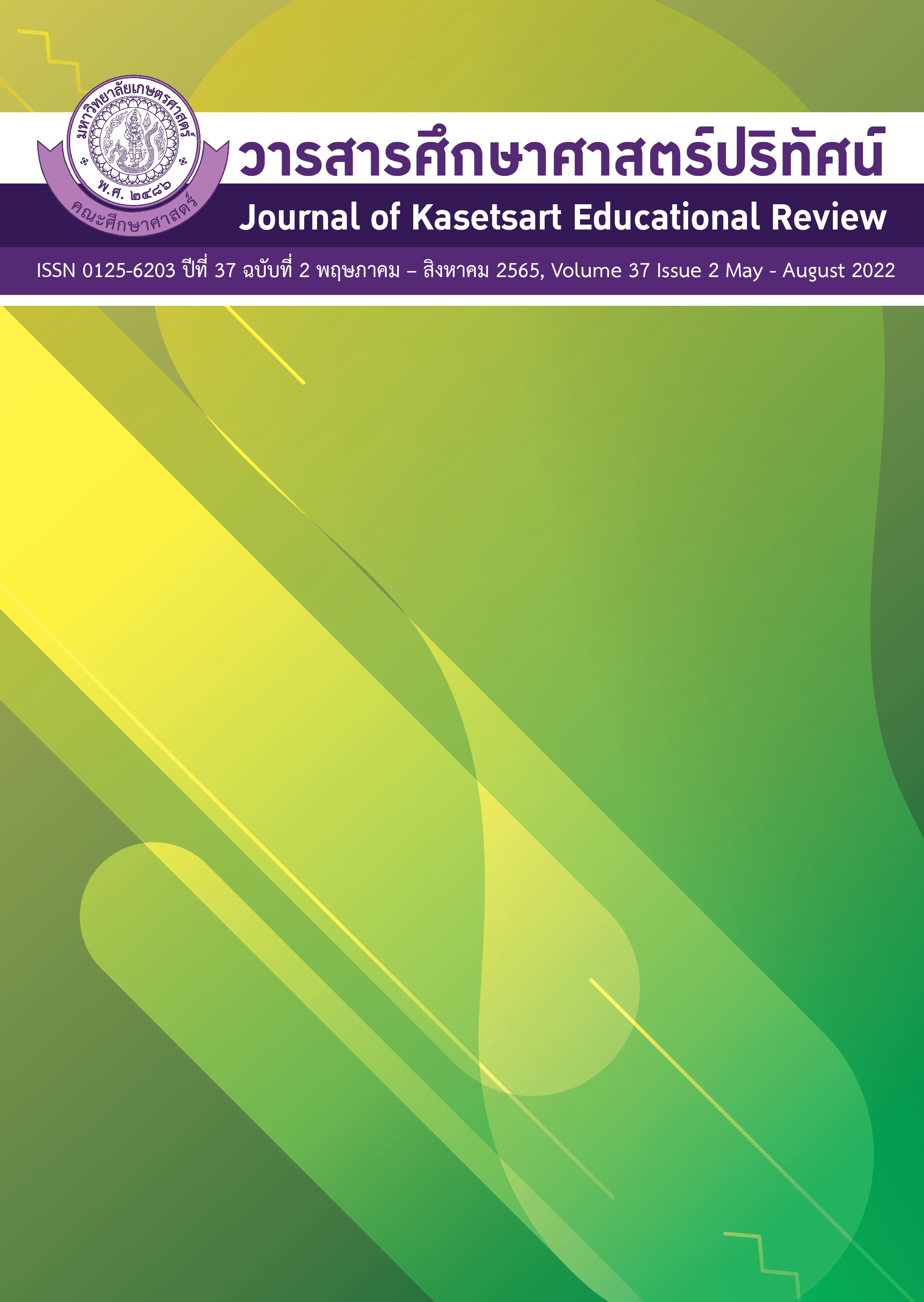การพัฒนาความเข้าใจธรรมชาติของวิทยาศาสตร์และความสามารถในการสร้างคำอธิบายทางวิทยาศาสตร์ โดยการจัดการเรียนรู้แบบชัดแจ้งและสะท้อนความคิด เรื่องแรงและเสียงของนักเรียนชั้นประถมศึกษาปีที่ 5 โรงเรียนวัดใหม่อมตรส กรุงเทพมหานคร
คำสำคัญ:
การจัดการเรียนรู้แบบชัดแจ้งและสะท้อนความคิด, ธรรมชาติของวิทยาศาสตร์, ความสามารถในการสร้างคำอธิบายทางวิทยาศาสตร์, นักเรียนชั้นประถมศึกษาบทคัดย่อ
การวิจัยเชิงปฏิบัติการนี้มีวัตถุประสงค์เพื่อ พัฒนาความเข้าใจธรรมชาติของวิทยาศาสตร์และความสามารถในการสร้างคำอธิบายทางวิทยาศาสตร์ของนักเรียนชั้นประถมศึกษาปีที่ 5 โดยการจัดการเรียนรู้แบบชัดแจ้งและสะท้อนความคิด เรื่องแรงและเสียง รวมทั้งศึกษาแนวปฏิบัติที่ดีในการจัดการเรียนรู้แบบชัดแจ้งและสะท้อนความคิด ศึกษากับนักเรียน 11 คน โรงเรียนวัดใหม่อมตรส เก็บรวบรวมข้อมูลจากแบบวัดความเข้าใจธรรมชาติของวิทยาศาสตร์ แบบวัดความสามารถในการสร้างคำอธิบายทางวิทยาศาสตร์ อนุทินสะท้อนความคิดของนักเรียน บันทึกหลังสอน และใบกิจกรรมของนักเรียน วิเคราะห์ข้อมูล โดยการวิเคราะห์เชิงเนื้อหา ความถี่และร้อยละ
ผลการวิจัยพบว่า 1) นักเรียนมีความเข้าใจธรรมชาติของวิทยาศาสตร์หลังเรียนในระดับความเข้าใจถูกต้องมากกว่าก่อนเรียน ประเด็นที่นักเรียนมีการพัฒนาความเข้าใจระดับถูกต้องสูงสุด คือ อิทธิพลของสังคมและวัฒนธรรมที่มีต่อวิทยาศาสตร์ และความรู้ทางวิทยาศาสตร์สามารถเปลี่ยนแปลงได้ ตามลำดับ 2) ความสามารถในการสร้างคำอธิบายทางวิทยาศาสตร์ของนักเรียนหลังเรียนเพิ่มขึ้นกว่าก่อนเรียน คือ อยู่ในระดับดี จำนวน 2 คน (ร้อยละ 18.18) ระดับปานกลาง จำนวน 5 คน (ร้อยละ 45.45) และระดับปรับปรุง จำนวน 4 คน (ร้อยละ 36.36) องค์ประกอบที่มีการพัฒนามากที่สุดคือข้อกล่าวอ้าง รองลงมาคือหลักฐาน 3) แนวปฏิบัติที่ดีในการจัดการเรียนรู้แบบชัดแจ้งและสะท้อนความคิด มีดังนี้ (1) การใช้คำถามและอภิปรายเกี่ยวกับประเด็นธรรมชาติของวิทยาศาสตร์ที่เชื่อมโยงกับกิจกรรมการสืบเสาะ หรือกิจกรรมทางวิทยาศาสตร์ในบทเรียน ช่วยส่งเสริมความเข้าใจธรรมชาติของวิทยาศาสตร์ ประเด็นหลักฐานเชิงประจักษ์ (2) การสร้างความเข้าใจเกี่ยวกับคำอธิบายทางวิทยาศาสตร์ที่ชัดแจ้งผ่านการเขียนคำอธิบายทางวิทยาศาสตร์ ช่วยให้นักเรียนสร้างคำอธิบายทางวิทยาศาสตร์สำหรับเหตุการณ์หรือปรากฏการณ์ใหม่ได้
(3) การลงมือปฏิบัติกิจกรรมและอภิปรายแลกเปลี่ยนการอธิบายปรากฏการณ์ ช่วยส่งเสริมให้นักเรียนสร้างคำอธิบายทางวิทยาศาสตร์ที่เชื่อมโยงระหว่างข้อกล่าวอ้างกับหลักฐานได้ดี
เอกสารอ้างอิง
Abd-El-Khalick, F. and Lederman, N. G. (2000). Improving science teachers' conceptions of nature of science: A critical review of the literature. International journal of science education, 22(7), 665-701.
Abd-El-Khalick, F. and Lederman, N. G. (2002). Rutherford's enlarged: A content-embedded activity to teach about nature of science. Physics Education, 37(1), 64.
Chamrat, S. and Yutakom, N. (2008). Chemistry teachers' understanding and practices of the nature of science when teaching atomic structure concepts. Kasetsart Journal Social Science. 29(3), 228-239. [in Thai]
Chamrat,Yutakom, N. and Chaiso, P. (2009). Grade 10 science students’ understanding of the nature of science. KKU Research Journal, 14(4), 360-374. [in Thai]
Chomka, S. and Yutakom, N. (2017).The Sixth Graders’ Understanding of Nature of Science and Weather Concepts. J. Res. Unit Sci. Technol. Environ. Learning, 8(1), 85-100. [in Thai]
HongKerd, O. (2018). Development of grade 11 students' ability in making scientific explanation in unit of endocrine system using Socio scientific Issues (SSIs)-based teaching Master thesis, M.S.,Kasetsart University, Bangkok. [in Thai]
Kemmis, S. and Mc Taggart, R. (eds.). (1998). The Action Research Planner. 3rd ed. Australia: Deakin University Press.
Khishf, R. & Abd-El-Khalick, F. (2002). Influence of Explicit and Reflective versus Implicit inquiry oriented Instruction on Six graders’ views of Nature of Science. Journal of Research in Science Teaching: The Official Journal of the National Association for Research in Science Teaching, 39(7): 551-578.
Khishf, R. & Abd-El-Khalick, F. (2008). The development of seventh graders' views of nature of science. Journal of Research in Science Teaching: The Official Journal of the National Association for Research in Science Teaching, 45(4), 470-496.
Ladachart, L. and Suttakun, L. (2012). Exploring and Developing Tenth-Grade Students’ Understandings of Nature of Science. Princess of Naradhiwas University Journal. 4(2), 73-90. [in Thai]
Lederman, N. G. and Wade, P. and Bell, R. L. (2002). Assessing Understanding of the Nature of Science : A Historical Perspective In McComas, W. F. (ed), The Nature of Science in Science Education Rationales and Strategies. Dordrecht: Kluwer Academic Publishers, 334 – 337.
McNeil, K.L. and Krajcik, J. (2006). Supporting Students' Construction of Scientific Explanation through Generic versus Context-Specific Written Scaffolds. In Paper presented at the annual meeting of the American Educational Research Association, San Francisco, April, 2006.
McNeill, K. L., Lizotte, D. J, Krajcik, J., and Marx, R. W. (2006). Supporting students’ construction of scientific explanations by fading scaffolds in instructional materials. The Journal of the Learning Sciences, 15(2), 153-191
Organization for Economic Cooperation and Development. (2012). PISA scientific literacy: Pisa 2012 Assessment and Analytical Framework. Retrieved January 22, 2021.
Patamapongsa, A. (2012). The development of high school student's conception of photosynthesis and views of nature of science using inquiry-based/explicit NOS approach. Master thesis, M.S.,Kasetsart University, Bangkok. [in Thai]
Putnok,Th. and Boonyasiri, P. and Trivijitkasem, S.(2012). The Fifth Grade Students’ Understanding of Nature of Science. Retrieved January 22, 2021. [in Thai]
Panyo, P. and Faikhamta, Ch. (2016). The Development of Grade-11 Students’ Understanding of the Nature of Science Using Explicit and Reflective Approach in the Unit of Solid, Liquid and Gas. J.Res. Unit Sci. Technol. Environ. Learning, 7(2), 265-284. [in Thai]
Pakdee, K. and Faikhamta, Ch. and Suwanruji, S. (2017). Developing tenth grade students’ views of nature of science in the topic of properties of elements and compounds. Journal of Education Naresuan University, 19(3), 77-90. [in Thai]
Sangwanpetch, N. (2015). The Development of Grade 10 Science-Gifted Students’ Understanding of the Nature of Science inthe Unit of Atomic Structure. M.S., Kasetsart University, Bangkok.. [in Thai]
Tarawan, M. and Nuansri, M.(2021). The Development of Grade 6 Students’ Scientific Explanation Ability in the topic of Natural Phenomenon and Geohazard using Model-Based learning Management. Journal of Roi Kaensarn Academi, 14(4), 20-33. [in Thai]
Yacoubian, H. A., and BouJaoude, S. (2010). Improving Science Teachers’ Conceptions of Nature of Science: A Critical Review of the Literature. International Journal of Science Education 22(7): 665-701
Zangori, L. and Forbes, C.T. (2014). Scientific practices in elementary classrooms: Third-grade students’ scientific explanations for seed structure and function. Science Education 98: 614-639.
ดาวน์โหลด
เผยแพร่แล้ว
ฉบับ
ประเภทบทความ
สัญญาอนุญาต
ลิขสิทธิ์ (c) 2022 วารสารศึกษาศาสตร์ปริทัศน์

อนุญาตภายใต้เงื่อนไข Creative Commons Attribution-NonCommercial-NoDerivatives 4.0 International License.
บทความทุกบทความเป็นลิขสิทธิ์ของวารสารคณะศึกษาศาสตร์ มหาวิทยาลัยเกษตรศาสตร์ วิทยาเขตบางเขน
วารสารศึกษาศาสตร์ปริทัศน์ (Kasetsart Educational Review)






